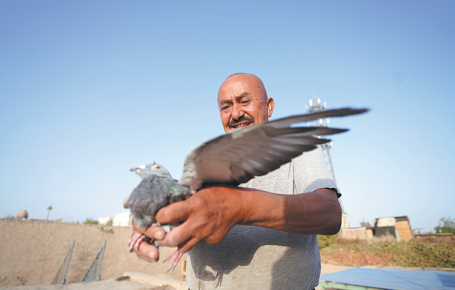Pigeon breeders' incomes flying high
Villagers are seeing their lifestyles improve as the birds become increasingly popular as a source of food and leisure fun. Li Hongyang reports from Turpan, Xinjiang Uygur autonomous region.

Nearly all the residents of a village in Turpan city, Xinjiang Uygur autonomous region, have pigeon cages on the roofs of their single-story houses.
For about a century, people in Xinchengximen bred the birds as a hobby, but over the past year, they have developed their pastime into an industry that is raising residents' incomes.
"Pigeons are easy to raise. They eat less than chickens, but grow faster. Turpan has a hot, dry climate, which pigeons like," said villager Mehmut Memet, who began breeding the birds when he was 7.
It usually takes a fledgling 30 days to reach full adulthood, while newly hatched chicks need about 90 days, the 41-year-old said.
In the village, most of the residents-98 percent of them are members of the Uygur ethnic group-began keeping pigeons during childhood because their fathers, uncles and grandfathers raised the birds as a leisure activity.
"Pigeons are cute. They can recognize the people who feed them and will gather around them. I used to climb to our roof after school to play with the birds," Mehmut said.
He added that breeding the birds is a highly profitable activity as some types are sold for their meat, while others are simply ornamental.
Despite Turpan's long history of pigeon breeding, a lack of technology and techniques prevented previous generations from developing it into a major source of income, according to Askar Memet, the village Party chief.
"People can earn enough money to provide for a family of four for a month by selling just nine pigeons for about 270 yuan ($42) in total. With the money, they can buy a bag of wheat, some meat and a bottle of cooking oil," he said.
Grapes remain the dominant industry in the village, where the long hours of sunshine are favorable to the cultivation of the local sweet-flavored variety. The residents plant the fruit on their 153 hectares of communal land.
"However, in this village of about 3,100 residents, the amount of arable land per capita does not provide enough income. Pigeon breeding only takes a little space and the birds lay more eggs than chickens over the same period," Askar said.
To attract more people to the activity, the village committee introduced pigeons from Shandong province and gave them to people who had experienced difficulties starting businesses.
Breeding experts from the Turpan science and technology bureau were also invited to give lessons to the villagers. Last year, a team of experts and officials from Hunan province came to support the area's development. They provided the locals with free pigeon cages.
Outside support
The team built a cultural square for pigeon trading and appreciation, and other forms of entertainment such as singing and dancing. Some of the experts also provided information about breeding techniques.
"We sell pigeons both online and offline. We promote our products on Douyin (a short-video app, known as TikTok in the West) and WeChat," Askar said.
Currently, about 200 villagers breed about 10,000 pairs of pigeons in the village every year.
Last year, each breeder saw their income rise by between 1,500 and 4,000 yuan on average, according to the village committee.
Turdi Mehmutul, who owns 200 pigeons, earned about 50,000 yuan last year by selling the birds and their eggs.
"Many people in the village made a profit by raising pigeons, so I decided to follow them in 2017. When I was 5, my parents and neighbors bred the birds for fun. I didn't see any value in them until I did some research and found that their meat is nutritious," he said.
The 60-year-old used to make a living through the fur trade, but the sector is increasingly insecure nowadays. "The business is not as profitable as before, so I must find another income source," Turdi said.
He began with 20 pigeons, but they all died. "I used the wrong breeding methods. After asking the experts, I learned that pigeons get ill when they eat too much or when the seasons change. By then, it is usually too late to give them medicine, so prevention is vital," he said.
Preventive measures include feeding the birds additive-free cereals and ensuring that their cages have adequate ventilation, he said.
Armed with this know-how, it takes Turdi less than an hour to feed his pigeons twice a day. He said he doesn't need to rely on his children now as he can earn a living on his own.
The only problem is that he needs to climb an iron ladder, about 2 meters high, to get to the pigeon cages on his roof.
Askar, the Party chief, said the village committee has established a pigeon-breeding cooperative that covers 5,000 square meters. Breeders purchase the chicks and the cooperative manages them as a whole. At the end of each year, the breeders get a slice of the profits.
Xinchengximen lies just 5 kilometers from Turpan's downtown, so most of the young people live in the village but work in the city. That means most of the breeders are seniors.
"Some have difficulty climbing up to the roofs. We encourage them to join the cooperative to gain easier access to the cages and to collect the scattered pigeons to form a large-scale breeding operation," Askar said.
So far, 10 villagers have registered with the cooperative.
"We will conduct a survey of how many people want to start breeding but haven't yet done so. At the end of this year, we plan to involve all the individual breeders in the cooperative," Askar said.
"By developing new industries, including pigeon breeding, we aim to double our villagers' incomes within three years."




Today's Top News
- Hainan's special customs operations start strong
- Macao SAR holds flag-raising, reception to mark 26th anniversary of return to motherland
- China issues rules to regulate pricing practices of internet platforms
- US hits over 70 IS-linked targets in Syria in massive retaliatory strikes
- Coffee needs cooperation, not confrontation
- Technological innovation brings cultural heritage alive






























